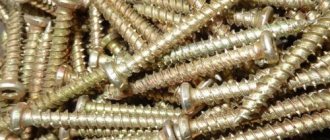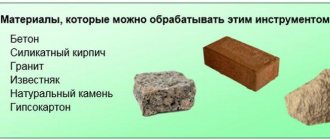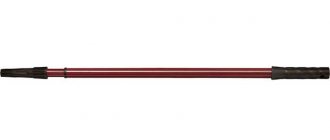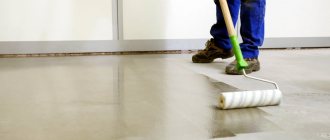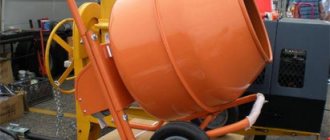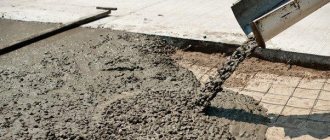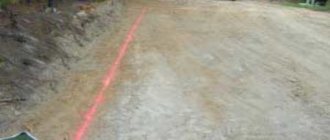A dowel for concrete is a type of fastening element. Used for insertion into vertical or horizontal cement-based structures. The concrete mass is characterized by high strength, so the fastening must withstand high loads. They are considering special fasteners that look like a self-tapping screw, but have improved characteristics.
How to screw a self-tapping screw into a brick. How to screw a self-tapping screw into a brick wall
First things first, first things tools
nails, screws, rivets, anchors
Reliable fastening of the structure is a guarantee that it will last a long time without requiring additional repairs
In this regard, it is very important to choose reliable tools and fastening elements. And this choice must be approached with full responsibility.
You will need special tools. An impact drill is best.
You can also choose a regular drill, to which a pobedit tip is selected. But in this case the work will be more complicated. In terms of cost, this will result in approximately the following figures: from 800 rubles for the tool itself and from 40 to 50 rubles in addition for the drill. Running sizes are considered to be 6 and 8 mm diameters.
The list of materials that such tools can work with is extensive. Their choice will depend on the future load of the suspended structure. The most popular are the following:
- self-tapping screws for bricks;
- dowels (will help withstand heavy loads);
- anchors (capable of holding very heavy things);
- rivets (for delicate glass shelves);
- corners (for small cabinets and shelves);
- regular nails combined with all the others.
It is also important to consider what kind of product is used for laying the surface - it can be either solid or hollow. The types and grades of this product will also tell you how reliable the screws used for bricks are
Main rules of fastening
correct fastening of screws
Before starting work, you need to understand some rules. They will help not to spoil the surface and carry out the correct fasteners:
- The most basic requirement that must be met when attaching something to a wall made of such material is not to spoil the mortar that holds the blocks together.
- It would be best to use a drill. It will help to avoid cracks that may appear if, for example, you try to “drive” self-tapping screws into a brick with a hammer drill.
- Drilling should be unhurried and gradual. This approach will help to secure any element to such a wall.
Working methods
working with self-tapping screws
There are several ways to make it easier to place fasteners on such a wall. Some of them are quite interesting:
If we are working with dowel nails, it is important to prepare a container with water - in it we will periodically cool the drill. You can wrap electrical tape around the drill itself, which will serve as a limiter.
After the hole is ready, insert the dowel glass and hammer in the nail. In order to facilitate the process that self-tapping screws go through when driven into a brick, you can use the “old” method. The dowel inserted into the drilled hole is strengthened with a wooden peg. Another “old-fashioned” method would be to drill a hole and screw a plug or cap into it, previously soaked in PVA glue. Then the “excess” peeking out from the wall is cut off and a self-tapping screw is screwed in. But such fastening is considered short-lived. It is best to use dowels designed specifically for brick walls. They have projections that will not allow it to turn, even if a screw or nail is screwed in. This rule applies even to hollow bricks, in which they will roll up into a knot and occupy the entire required volume. When you need to decorate an external wall (for example, the entrance of a house), you can use corners along with dowels and screws. They will not only connect the structure and the wall, but will even become supporting elements.
Varieties
Craftsmen classify this hardware according to two main characteristics, not counting size. The main thing is the type of head. There are models with countersunk, hexagonal and rectangular heads. The first ones have the aforementioned cross-shaped or conical splines. The hexagonal element is distinguished by an internal thread and a slot, which is intended for spanners and spanners. Rectangular models have a rounded head, which is also equipped with a technical loop. Now we can move on to the second classification criterion, which is also significant. On the construction market you can find concrete dowels made from different materials. To be more precise, the difference is rather in external technological coatings that perform protective functions. There are galvanized, blackened and copper-plated screw models. How are they different? Mainly by the conditions of use. Thus, galvanized models are recommended for use both indoors and outdoors. Copper dowel is afraid of external influences, so it is not advisable to use it outside. Blackened hardware is the least protected, so they should only be used in places that are well protected from moisture and oxidation.
How to screw it in?
In order for the self-tapping screw to be sufficiently firmly screwed into the concrete and ensure a strong fixation of the entire structure, you first need to check the material itself. If the concrete is “loose” and crumbles a little, then you should first make a small depression at the point where the device will be inserted.
The hole for the screw can be made using a Phillips screwdriver. If you don’t have it, take an awl, but it’s better not to use a drill. The recess made will not allow the element to move to the side during installation. It will be fixed strictly perpendicular to the surface.
During the screwing process, the self-tapping screw will begin to delaminate the material. When installing fasteners, it is necessary to take into account some rules. Remember that the length of the clamp should be significantly less than the thickness of the concrete. Otherwise, the tip of the fastener will simply end up on the outside of the other side.
Depending on the density of the concrete base, the distance between individual screws without drilling should be from 12 to 15 centimeters. If you are fastening the edges of concrete products, then you should leave a small distance from it. It should be twice the length of the latch itself.
The following video shows how to drive a screw into concrete.
What is it and where is it used
It is a regular self-tapping screw with a reinforced shaft and a hex head that can be screwed into concrete.
In addition to small items, you can use them to strengthen:
- door frames;
- frames;
- fencing;
- pipelines;
- heating radiators.
Below we will look in more detail at the types of such fasteners, as well as how to use concrete dowels correctly.
Hardware for concrete
Hardware products used for installation in concrete surfaces are usually classified according to the following criteria:
Types of dowel heads
The shape of the head directly affects the installation of the self-tapping screw. For example, screws in the form of hooks and studs are allowed to be installed only in a hole that has been pre-drilled and with a dowel. Other self-tapping screws for concrete are screwed in without drilling or with it.
Copper-plated screws for interior work
For example, screws with a hexagonal or countersunk head are screwed in without drilling a mounting hole. However, not every concrete is suitable for such installation.
Screw with variable thread and serrations along the entire length of the rod
Advice: cellular concrete is the best, but reinforced concrete is not suitable for this installation method.
The price of self-tapping screws depends on the scope of their application, the shape and pitch of the thread, and the length of the hardware also affects it. With a herringbone pattern, products will cost less than dowels and universal ones, and a screw 12 mm long will cost less than 200 mm, since less material and working time will be spent on it
How to use?
There are two ways to screw a dowel into a concrete wall - either with or without a dowel. The presence of a plastic sleeve in the hole will provide a more reliable grip thanks to its “shoots” that work as spacers. The use of a dowel is required in cases where there is an excessive load on the screw or the part needs to be secured to porous or cellular concrete. In principle, a plastic spacer should also be used when working on structures that are subject to vibration. Installing a self-tapping screw for concrete with a dowel begins with the fact that it is necessary to drill a recess in the wall, the diameter of which will coincide with the cross-section of the sleeve, and the depth will be 3-5 millimeters greater. You can drill with an electric drill, but when processing soft or porous materials it is better to use a screwdriver with a drill.
The hammer drill is used in situations where the density of the concrete wall is 700 kilograms per cubic meter or even more. The resulting hole is cleared of debris, and then the dowel is driven into the socket with an ordinary hammer. It will be correct to screw the self-tapping screw itself with a simple screwdriver or a screwdriver with a bat into an already prepared place. Installation of dowels on concrete can occur without preliminary drilling. This is done either according to a template or with preliminary application of a channel outline. When using a template, you will need to screw the hardware into the concrete surface directly through the hole of the pattern made from a piece of wood or a fragment of a board. If everything is done correctly, the fastener will be securely fastened perpendicular to the surface.
When working with basting, the hole will need to be drilled slightly smaller than the diameter of the screw itself. A dowel with a herringbone thread is usually driven into concrete with a hammer. It should definitely be mentioned that the use of screws requires preliminary marking. The distance from the edge of the structure must be equal to at least twice the length of the anchor
In addition, it is important that the depth of the hole exceeds the length of the screw by an amount equal to its diameter. When working with lightweight concrete, you should select a planting depth of 60 millimeters, and for heavy blocks - about 40 millimeters
When a dowel is selected for fixing wooden structures or window frames on concrete or brick walls, the surface is first cleaned and a recess is drilled with a drill. Further, approximately 5-6 centimeters retreat from the edge. When installing PVC window frames, the gap between the screws is maintained at 60 centimeters. In the case when we are talking about wooden or aluminum structures, you will need to maintain a distance of 70 centimeters, and plus maintain 10 centimeters from the corner of the frame to the racks.
Some experts recommend soaking the drill in water or oil during the work process to avoid excessive heat. If the dowel will be screwed in with a screwdriver, it should be selected in accordance with the drawings printed on the head of the product. Both curly and cross-shaped varieties can be suitable
To remove a broken screw from a concrete wall, it is better to drill the area around it and carefully pick up the fasteners with thin round nose pliers. Next, the resulting hole is closed with a plug of the same diameter, coated with PVA glue, or filled with a larger dowel
To screw the baseboards with self-tapping screws on concrete, manipulations will need to start from the inner corner of the room.
Having made the markings, you need to prepare holes for screws in the baseboard and on the wall. First, the dowels are attached, and then the plinth is carefully fixed to the wall using self-tapping screws. In the case when the surface is made of concrete, a recess equal to 4.5 centimeters is usually drilled, and the fasteners themselves are carried out at a distance of 3 centimeters. When working with a wall made of sand-lime brick, the hole will need to be deepened by 5.5 centimeters, and anchoring will be carried out to a depth of 4 centimeters. This type of self-tapping screws can also be used for pumice surfaces - in this case, you will first need to create a recess equal to 6.5 centimeters, and keep the gap between the hardware equal to 5 centimeters.
To learn how to drive a screw into concrete, watch the following video.
What is a concrete dowel and what does it look like?
A bolt is a shaped nail of round or square cross-section with a thread, without a pronounced point at the end with a hexagonal head, which can be screwed into concrete. The screw is made of galvanized steel, which guarantees its maximum service life even in wet environments. The unevenness of the thread ensures reliable fixation of the dowel screw in the concrete surface. The fastener is also suitable for bricks (solid with a void volume of less than 13% of its volume, and hollow with more than 14%). Dimensions range from 7 to 200 mm, its diameter is 3-6 mm. The metal tip allows the hardware not to “lick off” when screwed into a brick. For concrete, dowels are made from the following materials:
- alloy of iron and carbon;
- stainless steel.
Dowel selection
When purchasing various objects to attach to a concrete wall, you should choose the right dowel for concrete; its approximate dimensions can be selected from the table:
Table for determining the dimensions of a fastener depending on the type of load on it
Fasteners are selected depending on the type of place where they will be used.
Before driving a dowel into a concrete wall, the future load must be taken into account:
To secure structures of large mass, for example, wall bars or wall-mounted exercise machines, it is best to use dowels with a mounting depth of at least 85 mm; When fixing horizontally into a concrete wall, it is recommended to purchase fastening elements in which the fastening depth is at least 30 mm, and the diameter of the dowel on the outside is 7 - 11 mm; For the installation of a suspended ceiling, lamps, where the main load is located below, fasteners should be selected with spacer antennae and transverse notches; When selecting dowels for an already drilled hole, it is important that the parameters of the fastener and the diameter of the hole match each other. In this case, the dowel for expanded clay concrete or other material must have a diameter no less than the size of the hole; When using mounting fasteners, in order to prevent the destruction of weak walls, the dowel should serve as a softening pad
In this case, the fastener fits quite tightly to the fastener, and the load is distributed evenly throughout the product.
Features of installing dowels in the wall
Technology for installing dowels in a concrete wall
To do the work yourself you need to purchase:
- Electric drill;
- Pobedit drill;
- Sharp nail;
- Dowel of the desired design;
- Electrical tape;
- Small hammer.
After preparing all the tools, you can begin installing the dowels.
Work instructions:
- Mark the installation location of the fasteners with a ballpoint pen or a simple pencil;
- A small indentation is made with a nail, hacksaw or pin. This will allow you to correctly align the drill when making a hole;
- If the number of dowels was calculated incorrectly, you can make the product yourself. To do this, take wooden blocks of the required length. They are given a rounded cross-section, thickening at the top and decreasing in diameter at the bottom. After this, screw the screws into the concrete without a dowel;
- A drill of the required diameter is inserted into an electric drill;
- The drill is placed in the previously made recess. The drill is positioned strictly perpendicular to the surface;
- The resulting dust and cement chips are removed from the drilled hole. This can be done using a vacuum cleaner;
- The dowel is carefully inserted and hammered in with a hammer, but not too hard, until it stops;
- A screw is screwed into the dowel if it is included in the structure.
To correctly hammer a dowel into a wall, you should watch the video in this article.
Installing a spring dowel
Part parameters
When choosing screws for concrete, their sizes must be selected according to the applied load.
- when fastening a cabinet that weighs five kilograms, you can use a screw with dimensions of 3 x 25 mm, where 3 is the diameter of the rod, 25 is its length;
- for fastening an object weighing 100 kg, it is better to take the self-tapping screw dimensions 10 x 160 mm;
- The sizes of screws, depending on their type, can be found in the table:
| Concrete dowel | Diameters, mm | Length, mm | Weight of 1 piece, gr. |
| Black | 7,5 | 52; 72; 92; 112; 132; 152; 182; 202 | From 10 to 36.2 |
| White | 2,5; 3; 3,5 | 10; 12; 13; 16; 20; 25; 30; 40; 45 | From 0.3 to 1.6 |
| Yellow | 2,5; 3; 3,5 | 10; 12; 13; 16; 20; 25; 30; 40; 45 | From 0.3 to 1.9 |
Regular straight cut of drywall
Before you start work, you need to prepare your workplace. Since the sheet is quite large, you will need plenty of space on the floor, and be sure to give yourself extra space to walk around the sheet, as stepping on drywall should only be done as a last resort. The floor surface must be dry and level, since during work you may need to step on the sheet, and the slightest unevenness on the floor will lead to damage or splitting. When cutting, quite a lot of dust is generated - in order not to contaminate the floor, it is recommended to use a special covering film.
Carefully place the sheet on the prepared floor surface.
IMPORTANT: Never throw a sheet of plasterboard on the floor - it can easily break. Using a tape measure and a simple pencil, make markings on a sheet of drywall, then, using a long ruler or rule, draw cutting lines
Using a tape measure and a simple pencil, mark the sheet of drywall, then use a long ruler or rule to draw cut lines.
Now, using a construction knife (it is advisable to use new blades for this operation), we cut the surface of the sheet along the drawn line. To make an even cut, do not use plastic or wooden tools, but only high-rigidity (metal) tools; to avoid injury, the tool must be of sufficient thickness. It is better to use a building level or rule.
There is no need to cut the sheet all the way through - this will ruin the floor; it is enough to cut the material a little less than halfway (the less you drag the knife along the line, the smoother the edge you will get). With sufficient skill, you will only need to make one cut. Lift the sheet and, holding the part to be cut with one hand, place a level or rule under the cut line (stepping back slightly towards the remaining part).
Release the sheet and break it at the cut site.
Then, turn the sheet over on its end and bend it along the cut line. Afterwards, carefully cut through the cardboard layer on the other side and separate the cut part.
Treat the cut edge with a special plane or a construction knife and sandpaper.
Requirements for the location of self-tapping screws for concrete
Before using screws, you need to mark the fasteners:
- they retreat from the edge of the structure to a distance of at least twice the length of the anchor;
- the depth of the hole must be greater than the length of the self-tapping screw by the value of one of its diameters;
- the minimum recommended dowel insertion depth for lightweight concrete is 60 mm; for heavy ones - 40 mm;
- distance between anchors - 120 mm for porous, 150 mm - for dense materials;
- The diameter of the hole must correspond to the cross-section of the dowel.
The fasteners are positioned so as not to cause the formation of cold bridges.
How to screw a dowel into concrete
- Before installing the structure, it is necessary to calculate the load. This is quite easy to do, since the diameter of the screws is standard. Lightweight items such as wall shelves can be mounted on 72mm long dowels. For heavy and bulky objects, the screw is selected individually.
- Before drilling, it is necessary to clean the wall surface. Future fastenings are marked on the surface. Before marking, you need to make sure that it does not fall into the passage of fittings or wiring. There should be no more than 60 centimeters between the fastening points; when installing windows, the step should be no more than 70 centimeters. 5-6 centimeters retreat from the edge of the wall.
- The depth of the drilled hole should be slightly greater than the length of the dowel. If the hole is not deep enough, a metal pin can be used to achieve the desired depth. During installation, deviations from the drilling axis are unacceptable; the drill must be held strictly perpendicular to the wall. The hole is cleaned of dust using a cleaning rod or a construction vacuum cleaner.
- In the absence of a tool, simply use a drill to drill a preliminary hole. He is driven into the wall with a hammer. After several blows, turn and hammer again until a hole of the required size is obtained.
- When screwing the dowel into concrete, it is not recommended to use a screwdriver. Since the screw itself is quite fragile, it may not withstand excessive tightening and the heat generated during operation of the power tool. For installation use a simple screwdriver. If you have problems with screwing, it is better to take a hammer. When screwing a screw into a wall made of porous concrete, the installation must be done carefully.
Concrete dowel - technical specifications
Self-tapping screws (without drilling concrete) are made on the basis of hardened steel , which gives the product increased strength. A yellow galvanic zinc coating is applied to the surface. The treatment improves the mechanical characteristics and anti-corrosion properties of fasteners.
The greater the depth of fastening, the higher the load-bearing capacity of the screw. The product is effective in case of pulsating load
Phillips screws are ideal for use with a standard hand screwdriver or power tool. TORX slot, fasteners with loops, convex heads, heads with external threads, hexagon (wrench) are used with the corresponding type of tool.
The thread is cut unevenly. The quality of adhesion of the surface and fasteners is improved by applying special notches. The dowel adheres well to porous substrates and hollow blocks.
How to screw in a self-tapping screw when installing drywall
Before you screw a self-tapping screw into drywall, you need to think about tools that can make the job easier. Let's look at what tools and devices can be used: For a repairman, screwing in self-tapping screws is something understandable that does not raise any questions. Beginners believe that attaching drywall to the frame using self-tapping screws is the easiest to repair. But not everyone knows how to screw a self-tapping screw into drywall so that there are no problems later. Errors at this stage of repair can lead to the creation of a fragile coating.
The screws must be screwed in from one edge of the sheet to the other. You cannot screw them in at random, as this can lead to deformation of the drywall. The fastening pitch ranges from 15 to 30 cm, depending on the specific situation. The screwdriver applies slight pressure on the fastener and turns on maximum speed.
This is necessary so that the screw can fit into the profile to which the gypsum board is attached. As soon as it passes into the profile, you can reduce the speed and tighten the screw slowly. If the speed is not reduced, the sheet core will be damaged. The screw should fit into the sheet so that the head sank into it by 1-2 mm.
You need to work with a screwdriver gently, without much effort at first. If the self-tapping screw has not yet begun to enter the plasterboard, then the screwdriver under pressure may jump off and pierce the surface. When the screw has entered a little into the core of the material, you can already apply more force to screw it in completely.
Additional information on the topic:
- What is the difference between ceiling plasterboard and wall plasterboard
- Projects of plasterboard ceilings with suspended ceilings
- How to properly glue serpyanka to drywall when puttingtying
- What is needed for a plasterboard suspended ceiling
- Prices for puttying plasterboard ceilings for painting
Characteristics of self-tapping screws
The appearance of the screw indicates the use of a specific alloy. The silver color is associated with the use of zinc; this electroplating is used both on the outside and on the inside of the structure, and is considered universal. Yellow zinc is used on elements to a limited extent; such self-tapping screws are suitable exclusively for indoor work, most often for aerated concrete. It is made of carbon steel with a countersunk head with a Torx slot, double threads and a sharp tip (FRS-S). Black colored fasteners, which are achieved by chemical oxidation, are considered quite durable, but are used only inside a building with a normal percentage of humidity. Anchor heads for concrete are:
Screws with a torx head with an asterisk allow you to achieve the tightest possible fit of the fastener to the product.
- with cross slot;
- rectangular;
- with hook;
- with a torx head under an asterisk;
- hexagonal;
- spire-shaped.
Drilling drywall
Due to the great softness of drywall, almost any drills, drills and crowns can be used to drill sheets. However, preference should be given to drills (including feather drills) for wood, as well as crowns for wood and ceramics.
When drilling, it is advisable to place a wooden block or other not too hard material on the opposite side of the sheet, and, in the case of using a crown, you should drill approximately halfway on one side and finally on the opposite side, this way you can avoid chipping of the soft plaster on the back side of the sheet .
Screw for concrete - main advantages
Compared to other types of fasteners used for screwing into various materials, concrete dowels have a number of advantages:
- increased strength, allowing for reliable fixation of massive products;
- the presence of a reliable galvanic coating that protects the metal from corrosion;
- versatility and multifunctionality, allowing you to choose a screw for various purposes.
Thanks to these advantages, concrete screws (nails) are widely used by home craftsmen and professional builders.
Types and sizes
Depending on the type of head, all self-tapping screws can be divided into several independent groups.
Varieties with a countersunk head. Such models most often have a conical design with cross-shaped slots. To work with this variety, you first need to prepare a seat. To do this, you need to make a small chamfer, which will allow you to place the end so that it is in the plane of the material. Models with this head structure will not protrude above the concrete surface after installation. Today varieties with a reduced head are produced. They have a smaller diameter and provide a more reliable fastening, but more effort must be applied when installing them.
Self-tapping screws can also be divided into separate categories depending on their protective coating. Many models are produced with a special oxidized coating. The latter has the appearance of a thin oxide film, which gives the parts a black color. Such options can withstand significant loads, but we must not forget that they should not come into contact with moisture during operation.
There are also models coated with phosphated compounds. These varieties, like the previous version, will be painted black. They are also capable of fixing material of significant weight, and at the same time have good resistance to water. The cost of such models will be higher compared to other types.
Galvanized concrete screws can be white or yellow, but they practically do not differ from each other in important properties. These models are most often used for installing products that will be located outdoors, since these self-tapping screws are particularly resistant to various atmospheric influences.
Self-tapping screws are also classified depending on the material from which they are made. The most common option is high-strength and high-quality carbon steel. This foundation is considered quite strong. Most often it is used together with impurities. In addition, this metal is particularly durable. Fastening devices made from this metal are relatively inexpensive.
Also, ordinary stainless steel can be used to produce such self-tapping screws. This material will be the best option if contact of fasteners with moisture is possible in the future. After all, models made from such material will not rust and will not lose their properties.
As a rule, self-tapping screws made of alloy stainless steel are not coated with additional protective coatings. After all, such metal contains nickel and chromium, which already provide excellent anti-corrosion properties of products.
There are also special types of decorative screws. They are most often made of wood, plastic or various non-ferrous metals. But such samples are extremely rarely taken for concrete surfaces, since they cannot withstand too heavy loads.
The sizes of self-tapping screws for concrete may vary. They are selected depending on the thickness of the surface and the diameter of the holes made.
Tools may have different thread configurations.
- "Herringbone". This type is a slightly inclined thread, which is formed by small metal cones nested inside each other. The herringbone model most often has a cross-section of 8 millimeters.
- Universal. This type of self-tapping screw can be used with or without a dowel. As a rule, the tool is available in sizes up to 6 millimeters.
- With a variable pitch of turns. These samples with variable pitch provide the most reliable fastening of materials, while additionally performing notches. It is this type that is most often found on self-tapping screws without drilling. The standard diameter of such devices is 7.5 millimeters.
The length of these devices can vary from 50 to 185 mm. The depth ranges from 2.3 to 2.8 mm. The height of the cap reaches 2.8-3.2 mm. The diameter of such screws can be from 6.3 to 6.7 mm
The thread pitch also plays an important role. For different models it can reach a value of 2.5-2.8 mm
How to choose the right dowel
When you plan to purchase concrete screws, the application (intended purpose) of such fasteners is one of the criteria. This is due to the fact that the parameters are determined by the material and the type of thread of the hardware.
Criterias of choice:
- the type of structure, the material from which it is made, while considering different screws that differ in properties, type of coating, for example, to fix heavy structures of more than 100 kg, products with a length of 150 cm are used;
- choose products according to the type of head: protruding, hidden;
- The type of slot also plays a role, and you need to choose the right tool;
- a type of thread, which determines the method of installing hardware (with dowels, in a finished hole, etc.);
- operating conditions, some types of fasteners are negatively affected by moisture.
General information
Although the modern construction market offers many options, self-tapping screws remain the most popular. They are screws of a rod-shaped, pointed shape, the head of which has a cross notch. Such a fastening element is characterized by high strength, which allows it not to bend or collapse under the influence of heavy loads.
How to use a concrete screw when working with foam concrete
Material
For the manufacture of self-tapping screws, various materials can be used, which are selected depending on the type and conditions of use.
The main ones are:
- carbon steel;
- stainless steel;
- brass.
The common feature of each of them is high strength, and their prices are not much different from each other.
The most common fasteners are made from carbon steel. Such self-tapping screws have an additional protective coating that protects them from oxidation and other types of influences.
Anchor screws for concrete
In order not to get confused about the types of coatings for carbon steel, you need to remember their color designation:
| Silver | In this case, the protective coating is a layer of zinc. Such self-tapping screws can be used equally effectively for various jobs. |
| Yellow | Such fasteners are also treated with zinc, but they have a slight drawback compared to silver ones. It can only be used when working with concrete indoors. |
| Black | Another type of coating for carbon steel screws is oxidized. They are recommended for use during interior work in rooms with normal air humidity levels. |
Before installing the self-tapping screw, make a hole for the dowel using a hammer drill
Types of hardware
Fasteners differ in color:
- black: with a protective film, the concrete screw (dowel) does not withstand direct exposure to moisture, therefore it is used only indoors with a normal level of humidity;
- yellow: yellow zinc is used in production, such screws are not intended for use outside the premises;
- silver: zinc is applied to products by galvanic means, which makes the fasteners universal.
Concrete screws (dowels) are divided into groups taking into account the differences in head shapes:
- secret;
- with a protruding head.
In the first case, it becomes possible to hide the fasteners. In this case, the self-tapping screw is completely buried in the concrete mass. The cap does not rise above the surface. Products with a protruding head remain visible when installed in concrete. Possible types of fasteners, which differ in the shape of the cap:
- hexagonal;
- conical in shape with a slot of different configurations (cross-shaped, in the form of a multifaceted asterisk).
A hairpin or self-tapping screw without a head is considered separately. A nut is loosely screwed onto such an element.
When choosing concrete screws, their dimensions are studied first:
- universal, they are characterized by a length of no more than 20 cm, cross-sectional size of no more than 6 mm;
- with inclined thread, such self-tapping screws are used only in conjunction with dowels; holes are pre-drilled for installation in a concrete mass;
- with intermittent threads, cross-sectional size - up to 7.5 mm, length varies from 7 to 20 cm, this type of product is designed to simplify the process of introducing a fastening element into concrete, but preliminary drilling of the structure is required.


